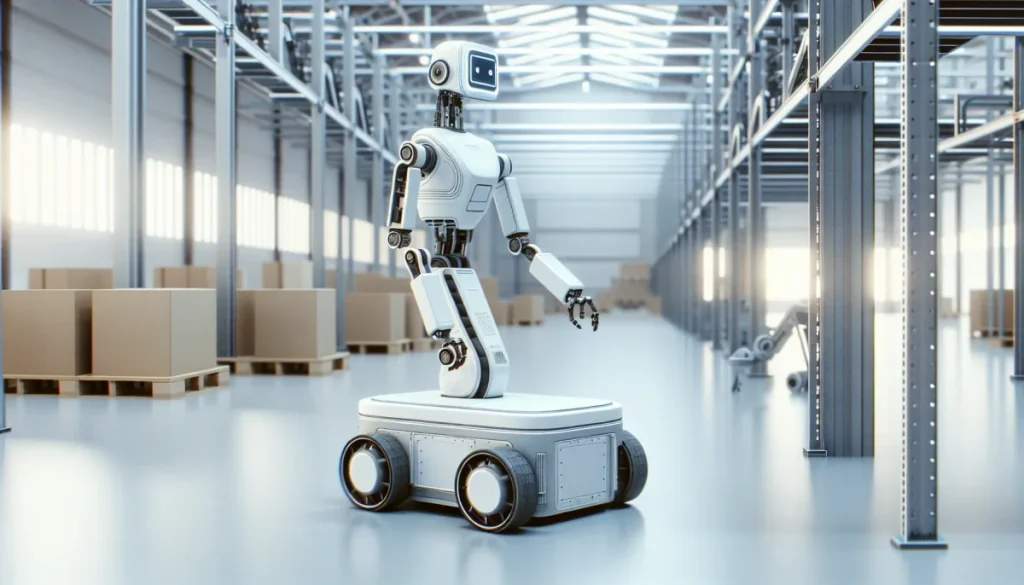In a groundbreaking demonstration, Boston Dynamics has unveiled the latest iteration of their Atlas robot, showcasing its ability to perform complex industrial tasks autonomously. This reveal marks a significant leap forward in robotics technology, with Atlas demonstrating capabilities that could revolutionize various industries, particularly in logistics and manufacturing.
The Atlas Demonstration
The demonstration, featured on Boston Dynamics’ YouTube channel, presents Atlas executing a series of loading and unloading tasks involving engine covers. What sets this demonstration apart is its unpolished nature, reflecting real-world working conditions rather than a carefully curated environment. The robot operates autonomously for 2 minutes and 30 seconds, making decisions based on pre-programmed logic and real-time sensor inputs without human intervention or remote control.
This level of autonomy is a game-changer in the field of robotics. Atlas’s ability to carry out repetitive and potentially dangerous tasks safely and efficiently on its own opens up new possibilities for industrial applications. The robot’s capability to handle large, unwieldy objects with precision is particularly noteworthy, as it addresses a critical need in many industrial settings.
Key Features of Atlas’s Performance
- Autonomous operation without human intervention
- Handling of heavy, bulky engine covers with precision
- Navigation between supply containers and a mobile sequencing dolly
- Use of machine learning vision models for object detection and localization
- Implementation of specialized grasping policies
- Continuous estimation of manipulated object states
- Real-time adaptation to environmental changes
Advanced Perception and Decision-Making
Atlas’s performance is underpinned by sophisticated perception and decision-making capabilities. The robot receives a pre-mapped list of bin locations, allowing it to navigate its workspace efficiently. However, what truly sets Atlas apart is its use of machine learning vision models to detect and localize environmental fixtures and individual bins.
This visual understanding enables Atlas to differentiate between various objects and determine their exact positions in three-dimensional space. Such capability is crucial for effective interaction with the environment and successful task completion.
Grasping and Object Manipulation
One of the most impressive aspects of Atlas’s performance is its specialized grasping policy. This set of rules governs how the robot approaches and handles different objects, taking into account factors such as optimal grip strength and approach angles. The robot continuously monitors the state of objects it’s manipulating, allowing it to make real-time adjustments if it detects any issues such as slipping or misalignment.
This continuous estimation and adjustment capability is essential for ensuring task completion and adapting to unexpected conditions. It’s a key factor in Atlas’s ability to work effectively in dynamic environments where conditions may change rapidly.
Real-Time Adaptation and Error Handling
Perhaps one of the most impressive features demonstrated by Atlas is its ability to detect and react to changes in its environment, including action failures. The robot can identify issues such as failure to insert a cover properly or potential collisions, and respond accordingly. This adaptability is crucial for real-world applications where workspaces are often dynamic and unpredictable.
Atlas uses a combination of vision, force, and proprioceptive sensors to understand its environment and its own body state. This multi-modal sensing approach allows the robot to quickly identify and correct errors, ensuring smooth and efficient operation even in challenging conditions.
Versatility and Modularity
A subtle but significant feature of Atlas is its versatility, particularly in its end effectors or “hands.” The demonstration showcased Atlas using a three-finger hand/gripper that can function as an opposable thumb, allowing for multiple grip configurations. This adaptability enables Atlas to handle a wide variety of objects and tasks.
Furthermore, the robot’s design appears to allow for modular changes to its end effectors. This feature, while not explicitly demonstrated in the main video, suggests that Atlas could be quickly adapted for different tasks by swapping out its hands or other components. Such modularity could greatly enhance the robot’s utility across various industrial applications.
Implications for the Future of Robotics
The Atlas demonstration represents a significant step forward in the field of robotics, particularly in the realm of autonomous industrial robots. The level of autonomy, adaptability, and precision demonstrated by Atlas suggests that we are on the cusp of a new era in industrial automation.
While some observers have noted that Atlas’s movements can appear uncanny or unnatural from a human perspective, it’s important to remember that these robots are not designed to mimic human movement exactly. Instead, they are optimized for efficiency and effectiveness in their tasks, which may result in movements that seem strange to human observers but are perfectly suited to the robot’s capabilities and objectives.
As robotics technology continues to advance, we can expect to see more sophisticated and capable robots like Atlas being deployed in various industries. These robots have the potential to transform workflows, increase efficiency, and take on tasks that are dangerous or difficult for human workers.
However, the introduction of such advanced autonomous robots also raises important questions about the future of work and the role of human workers in increasingly automated industries. As we move forward, it will be crucial to consider the societal and economic implications of these technological advancements and to ensure that the benefits of robotics are balanced with the needs of human workers and society as a whole.
Frequently Asked Questions
Q: What makes Boston Dynamics’ Atlas robot unique compared to other industrial robots?
Atlas stands out due to its advanced autonomy, ability to handle complex tasks without human intervention, and its adaptability to dynamic environments. Unlike many industrial robots, Atlas can make real-time decisions, adjust to unexpected changes, and perform a wide range of movements that optimize efficiency.
Q: How does Atlas perceive and interact with its environment?
Atlas uses a combination of machine learning vision models, force sensors, and proprioceptive sensors to understand its surroundings and its own body state. This multi-modal sensing approach allows it to detect objects, estimate their positions, and interact with them effectively while maintaining awareness of its own movements and balance.
Q: Can Atlas learn new tasks or is it limited to pre-programmed actions?
While Atlas operates based on pre-programmed logic, its use of machine learning models and real-time sensor inputs allows it to adapt to new situations and generate appropriate responses on the fly. This suggests a level of flexibility that could potentially be expanded to learn new tasks, although the extent of this capability wasn’t fully explored in the demonstration.
Q: What industries could benefit most from robots like Atlas?
Industries that involve repetitive, physically demanding, or potentially dangerous tasks could greatly benefit from robots like Atlas. This includes manufacturing, logistics, warehousing, construction, and possibly even disaster response or hazardous environment operations. The robot’s versatility and adaptability make it potentially suitable for a wide range of applications.
Q: What are the potential implications of robots like Atlas for human workers?
The introduction of highly capable robots like Atlas could lead to significant changes in the workforce. While they may replace humans in certain dangerous or repetitive tasks, they could also create new job opportunities in robot maintenance, operation, and programming. It’s crucial for society to address the potential economic and social impacts of increased automation and ensure a balanced approach to integrating this technology into the workforce.








